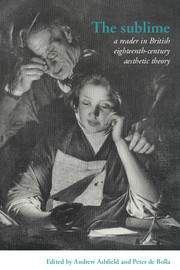Book contents
- Frontmatter
- Contents
- List of Abbreviations
- Introduction
- Part I The Longinian tradition
- 1 Dionysius Longinus on the sublime (1743)
- 2 Remarks on a book entitled, Prince Arthur (1696)
- 3 The advancement and reformation of modern poetry (1701)
- 4 The grounds of criticism in poetry (1704)
- 5 Essays upon several subjects (1716)
- 6 A miscellany of ingenious thoughts (1721)
- 7 An essay on the theory of painting (1725)
- 8 Reflections on the nature and property of languages (London 1731)
- 9 The works (1735)
- 10 Lectures on poetry (1742)
- Part II Rhapsody to rhetoric
- Part III Irish Perspectives
- Part IV The Aberdonian Enlightenment
- Part V Edinburgh and Glasgow
- Part VI From the Picturesque to the Political
- Sources and further reading
7 - An essay on the theory of painting (1725)
Published online by Cambridge University Press: 05 June 2012
- Frontmatter
- Contents
- List of Abbreviations
- Introduction
- Part I The Longinian tradition
- 1 Dionysius Longinus on the sublime (1743)
- 2 Remarks on a book entitled, Prince Arthur (1696)
- 3 The advancement and reformation of modern poetry (1701)
- 4 The grounds of criticism in poetry (1704)
- 5 Essays upon several subjects (1716)
- 6 A miscellany of ingenious thoughts (1721)
- 7 An essay on the theory of painting (1725)
- 8 Reflections on the nature and property of languages (London 1731)
- 9 The works (1735)
- 10 Lectures on poetry (1742)
- Part II Rhapsody to rhetoric
- Part III Irish Perspectives
- Part IV The Aberdonian Enlightenment
- Part V Edinburgh and Glasgow
- Part VI From the Picturesque to the Political
- Sources and further reading
Summary
Of the sublime
…By the sublime in general I mean the most excellent of what is excellent, as the excellent is the best of what is good. The dignity of a man consists chiefly in his capacity of thinking, and of communicating his ideas to another; the greatest, and most noble thoughts, images, or sentiments, conveyed to us in the best chosen words, I take therefore to be the perfect sublime in writing; the admirable, the marvellous.
But as there may be degrees even in the sublime, something short of the utmost may be also sublime.
Thought, and language are two distinct excellencies: there are few that are capable of adding dignity to a great subject, or even of doing right to such a one; in some cases none: the bulk of mankind conceive not greatly, nor do they know how to utter the conceptions they have to the best advantage; and those that have higher capacities exert them but rarely, and on few occasions: hence it is that we so justly admire what is so excellent, and so uncommon.
The great manner of thinking (as thought in general) is either pure invention, or what arises upon hints suggested from without.…
- Type
- Chapter
- Information
- The SublimeA Reader in British Eighteenth-Century Aesthetic Theory, pp. 45 - 48Publisher: Cambridge University PressPrint publication year: 1996

